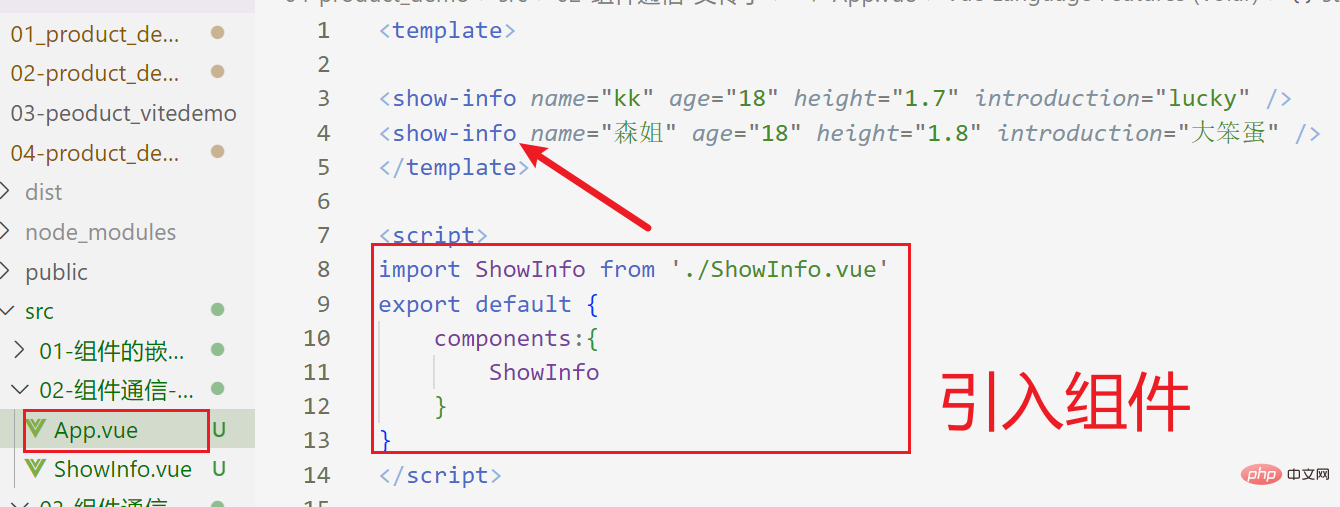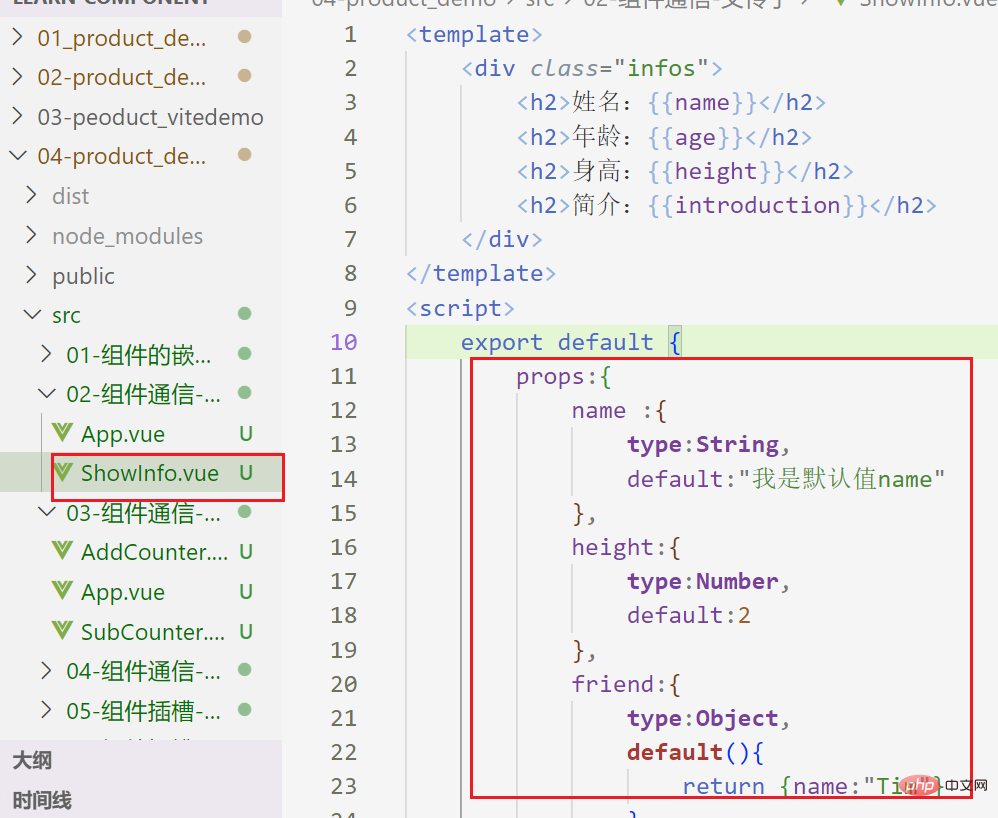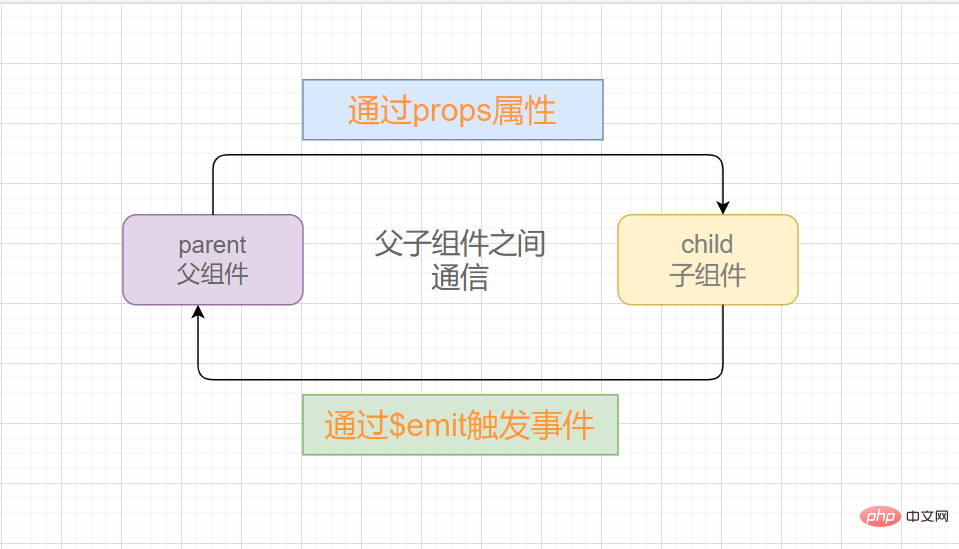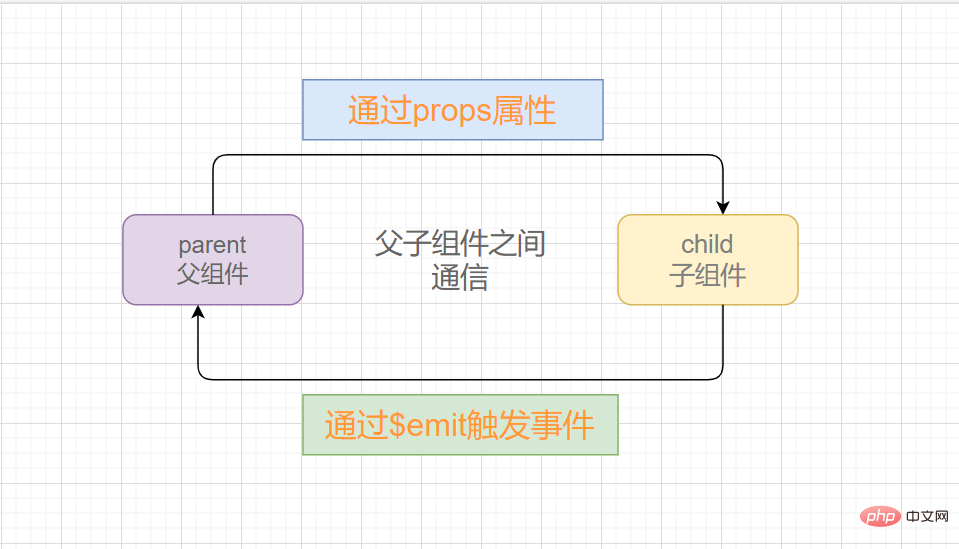 Web Front-end
Web Front-end
 Vue.js
Vue.js
 A brief analysis of how to communicate between parent and child components in Vue (pass from father to son|pass from son to father)
A brief analysis of how to communicate between parent and child components in Vue (pass from father to son|pass from son to father)
A brief analysis of how to communicate between parent and child components in Vue (pass from father to son|pass from son to father)
How to communicate between parent and child components in
Vue? The following article will introduce to you the methods of father to son and son to father. I hope it will be helpful to you!

1. Pass parent component to child component
⭐⭐
- Parent component is passed to the child component: through the props attribute; [Related recommendations: vuejs video tutorial, web front-end development]
- The child component is passed to the parent component: Trigger the event through $emit;

## Here we know that the parent component has some data that needs to be displayed by the child component, then we can pass
propsTo complete the communication between components
To complete the communication between components through props


2. A brief discussion on Props
⭐⭐ So what are
Props?
- Function: Accept the properties passed by the parent component
- Props
means you can register some custom attributes on the component;The parent component assigns values to these attributes (attributes), and the child component obtains the corresponding value through the name of the attribute;
script setup, props You can use the defineProps() macro to declare:
1 2 3 4 5 |
|
1) The array type
is not used ## In the component of #script setup, prop can be declared using the props option: <div class="code" style="position:relative; padding:0px; margin:0px;"><pre class="brush:php;toolbar:false">export default {
props: ['foo'],
setup(props) {
// setup() 接收 props 作为第一个参数
console.log(props.foo)
}
}</pre><div class="contentsignin">Copy after login</div></div>Example, use of object syntax
- App.vue
uses components and attributes defined by integer props
1
2
3
<template><show-info></show-info></template>Copy after login
- ##showInfo.vue
- SubcomponentAlso:
1
2
3
4
5
6
7
8
9
10
11
12
exportdefault{props:{name :{type:String,default:"我是默认值name"},height:{type:Number,default:2}}}Copy after loginSo what types of types can be?
String
- Number
- Boolean
- Array
- Object
- Date
- Function
- Symbol
- 2) Object type
is declared in the form of object
props (This is quite commonly used) Use script setup
1 2 3 4 |
|
non-script setup
1 2 3 4 5 6 |
|
⭐⭐ The child component is passed to the parent component and the event is triggered through $emit
The child component passes content to the parent component: 
When some events occur in the child component, such as a click in the component, the parent component needs to switch content;
- When the child component has some content that you want to pass to the parent component;
- $emit(“add”, count) The first parameter is the customized event name, and the second parameter It is the passed parameter
⭐⭐
Take a counter case
Here we have two sub-components and a parent component
- The sub-component is defined in The name of the event triggered in some cases
- In the parent component, pass in the name of the event to be monitored in the form of v-on (syntactic sugar @), and bind it to the corresponding method;
- Finally, when an event occurs in the child component, the corresponding event is triggered according to the event name
- 1) Parent component App.vue
The parent component listens to the addition or subtraction events of the child component, and the parent component listens to the event through the child component
- The parent component listens to the custom event emitted by the child component, and then performs the corresponding operation
1 2 3 4 5 6 7 8 9 10 11 12 13 14 15 16 17 18 19 20 21 22 23 24 25 26 27 28 29 30 31 32 |
|
What is defined here is the addition operation of the counter
After the subcomponent event is triggered, through this.$emit The way to emit events
1 2 3 4 5 6 7 8 9 10 11 12 13 14 15 16 17 18 |
|
3) Subcomponent 2
SubCounter.vue
What is defined here is the decrement operation of the counter
this.$emit
1 2 3 4 5 6 7 8 9 10 11 12 13 14 15 16 17 18 |
|
This case is very classic, you can think about it again and again~ (Learning video sharing: Programming Basic video
)The above is the detailed content of A brief analysis of how to communicate between parent and child components in Vue (pass from father to son|pass from son to father). For more information, please follow other related articles on the PHP Chinese website!

Hot AI Tools

Undresser.AI Undress
AI-powered app for creating realistic nude photos

AI Clothes Remover
Online AI tool for removing clothes from photos.

Undress AI Tool
Undress images for free

Clothoff.io
AI clothes remover

AI Hentai Generator
Generate AI Hentai for free.

Hot Article

Hot Tools

Notepad++7.3.1
Easy-to-use and free code editor

SublimeText3 Chinese version
Chinese version, very easy to use

Zend Studio 13.0.1
Powerful PHP integrated development environment

Dreamweaver CS6
Visual web development tools

SublimeText3 Mac version
God-level code editing software (SublimeText3)

Hot Topics
 1376
1376
 52
52
 How to reference js file with vue.js
Apr 07, 2025 pm 11:27 PM
How to reference js file with vue.js
Apr 07, 2025 pm 11:27 PM
There are three ways to refer to JS files in Vue.js: directly specify the path using the <script> tag;; dynamic import using the mounted() lifecycle hook; and importing through the Vuex state management library.
 How to use watch in vue
Apr 07, 2025 pm 11:36 PM
How to use watch in vue
Apr 07, 2025 pm 11:36 PM
The watch option in Vue.js allows developers to listen for changes in specific data. When the data changes, watch triggers a callback function to perform update views or other tasks. Its configuration options include immediate, which specifies whether to execute a callback immediately, and deep, which specifies whether to recursively listen to changes to objects or arrays.
 How to use bootstrap in vue
Apr 07, 2025 pm 11:33 PM
How to use bootstrap in vue
Apr 07, 2025 pm 11:33 PM
Using Bootstrap in Vue.js is divided into five steps: Install Bootstrap. Import Bootstrap in main.js. Use the Bootstrap component directly in the template. Optional: Custom style. Optional: Use plug-ins.
 What does it mean to lazy load vue?
Apr 07, 2025 pm 11:54 PM
What does it mean to lazy load vue?
Apr 07, 2025 pm 11:54 PM
In Vue.js, lazy loading allows components or resources to be loaded dynamically as needed, reducing initial page loading time and improving performance. The specific implementation method includes using <keep-alive> and <component is> components. It should be noted that lazy loading can cause FOUC (splash screen) issues and should be used only for components that need lazy loading to avoid unnecessary performance overhead.
 How to add functions to buttons for vue
Apr 08, 2025 am 08:51 AM
How to add functions to buttons for vue
Apr 08, 2025 am 08:51 AM
You can add a function to the Vue button by binding the button in the HTML template to a method. Define the method and write function logic in the Vue instance.
 Vue realizes marquee/text scrolling effect
Apr 07, 2025 pm 10:51 PM
Vue realizes marquee/text scrolling effect
Apr 07, 2025 pm 10:51 PM
Implement marquee/text scrolling effects in Vue, using CSS animations or third-party libraries. This article introduces how to use CSS animation: create scroll text and wrap text with <div>. Define CSS animations and set overflow: hidden, width, and animation. Define keyframes, set transform: translateX() at the beginning and end of the animation. Adjust animation properties such as duration, scroll speed, and direction.
 How to query the version of vue
Apr 07, 2025 pm 11:24 PM
How to query the version of vue
Apr 07, 2025 pm 11:24 PM
You can query the Vue version by using Vue Devtools to view the Vue tab in the browser's console. Use npm to run the "npm list -g vue" command. Find the Vue item in the "dependencies" object of the package.json file. For Vue CLI projects, run the "vue --version" command. Check the version information in the <script> tag in the HTML file that refers to the Vue file.
 How to return to previous page by vue
Apr 07, 2025 pm 11:30 PM
How to return to previous page by vue
Apr 07, 2025 pm 11:30 PM
Vue.js has four methods to return to the previous page: $router.go(-1)$router.back() uses <router-link to="/" component window.history.back(), and the method selection depends on the scene.




